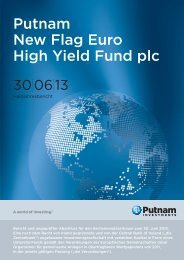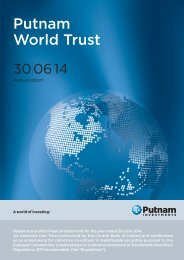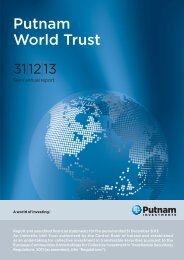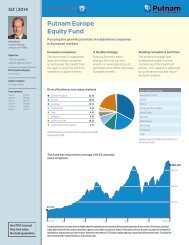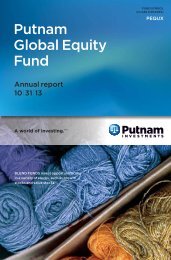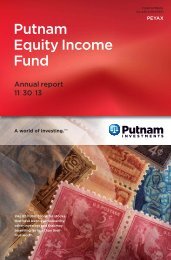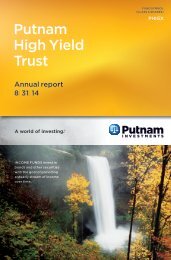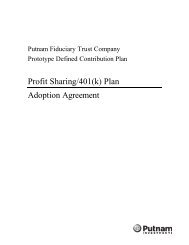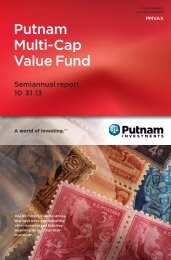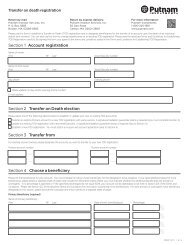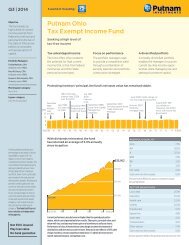Dynamic Risk Asset Allocation: Annual Report - Putnam Investments
Dynamic Risk Asset Allocation: Annual Report - Putnam Investments
Dynamic Risk Asset Allocation: Annual Report - Putnam Investments
Create successful ePaper yourself
Turn your PDF publications into a flip-book with our unique Google optimized e-Paper software.
<strong>Investments</strong> in open-end investment companies (excluding exchange traded funds), if any, which can be classifiedas Level 1 or Level 2 securities, are valued based on their net asset value. The net asset value of such investmentcompanies equals the total value of their assets less their liabilities and divided by the number of theiroutstanding shares.Market quotations are not considered to be readily available for certain debt obligations and other investments;such investments are valued on the basis of valuations furnished by an independent pricing service approvedby the Trustees or dealers selected by <strong>Putnam</strong> Management. Such services or dealers determine valuations fornormal institutional-size trading units of such securities using methods based on market transactions for comparablesecurities and various relationships, generally recognized by institutional traders, between securities (whichconsider such factors as security prices, yields, maturities and ratings). These securities will generally be categorizedas Level 2. Short-term securities with remaining maturities of 60 days or less may be valued at amortized cost,which approximates fair value and are classified as Level 2 securities.Many securities markets and exchanges outside the U.S. close prior to the close of the New York Stock Exchangeand therefore the closing prices for securities in such markets or on such exchanges may not fully reflect eventsthat occur after such close but before the close of the New York Stock Exchange. Accordingly, on certain days,the fund will fair value foreign equity securities taking into account multiple factors including movements in theU.S. securities markets, currency valuations and comparisons to the valuation of American Depository Receipts,exchange-traded funds and futures contracts. These securities, which would generally be classified as Level 1 securities,will be transferred to Level 2 of the fair value hierarchy when they are valued at fair value. The number of dayson which fair value prices will be used will depend on market activity and it is possible that fair value prices will beused by the fund to a significant extent. At the close of the reporting period, fair value pricing was used for certainforeign securities in the portfolio. Securities quoted in foreign currencies, if any, are translated into U.S. dollars atthe current exchange rate.To the extent a pricing service or dealer is unable to value a security or provides a valuation that <strong>Putnam</strong> Managementdoes not believe accurately reflects the security’s fair value, the security will be valued at fair value by <strong>Putnam</strong>Management in accordance with policies and procedures approved by the Trustees. Certain investments, includingcertain restricted and illiquid securities and derivatives, are also valued at fair value following procedures approvedby the Trustees. These valuations consider such factors as significant market or specific security events such asinterest rate or credit quality changes, various relationships with other securities, discount rates, U.S. Treasury,U.S. swap and credit yields, index levels, convexity exposures and recovery rates. These securities are classified asLevel 2 or as Level 3 depending on the priority of the significant inputs.Such valuations and procedures are reviewed periodically by the Trustees. Certain securities may be valued on thebasis of a price provided by a single source.The fair value of securities is generally determined as the amount that the fund could reasonably expect to realizefrom an orderly disposition of such securities over a reasonable period of time. By its nature, a fair value price is agood faith estimate of the value of a security in a current sale and does not reflect an actual market price, whichmay be different by a material amount.Security transactions and related investment income Security transactions are recorded on the trade date (the datethe order to buy or sell is executed). Gains or losses on securities sold are determined on the identified cost basis.Interest income, net of any applicable withholding taxes, is recorded on the accrual basis. Dividend income, net ofany applicable withholding taxes, is recognized on the ex-dividend date except that certain dividends from foreignsecurities, if any, are recognized as soon as the fund is informed of the ex-dividend date. Non-cash dividends, if any,are recorded at the fair value of the securities received. Dividends representing a return of capital or capital gains, ifany, are reflected as a reduction of cost and/or as a realized gain.All premiums/discounts are amortized/accreted on a yield-to-maturity basis.The fund earned certain fees in connection with its senior loan purchasing activities. These fees are treated asmarket discount and are amortized into income in the Statement of operations.Securities purchased or sold on a delayed delivery basis may be settled at a future date beyond customary settlementtime; interest income is accrued based on the terms of the securities. Losses may arise due to changes in thefair value of the underlying securities or if the counterparty does not perform under the contract.Stripped securities The fund may invest in stripped securities which represent a participation in securities that maybe structured in classes with rights to receive different portions of the interest and principal. Interest-only securities72 <strong>Dynamic</strong> <strong>Risk</strong> <strong>Allocation</strong> Fund



